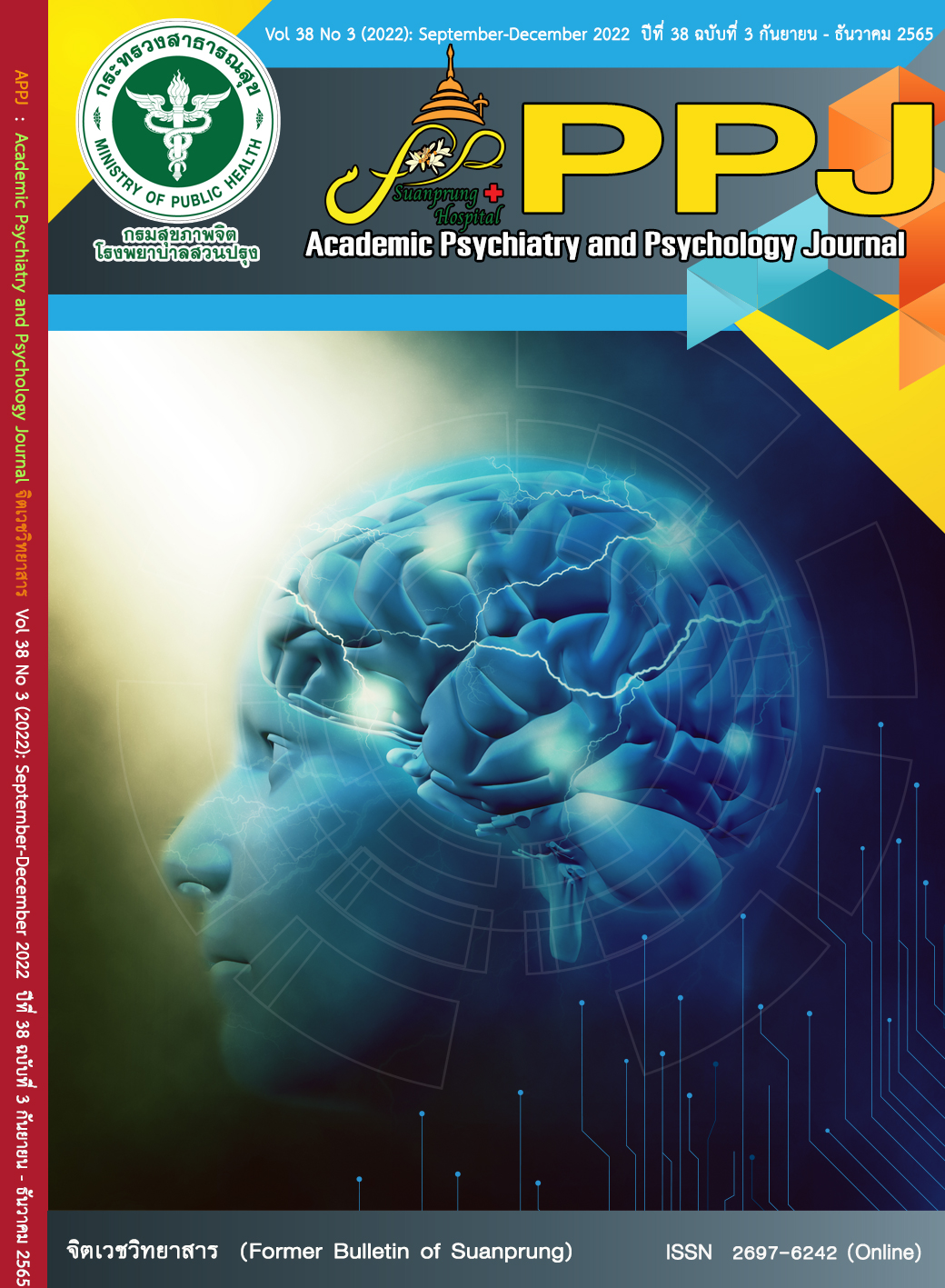Effects of combining movement and multisensory activities on praxis and quality of life in children with autism.
Main Article Content
Abstract
Objective: The purpose of this study was to determine the effects of combining movement and multisensory activities on praxis and quality of life in children with autism.
Material and methods: This experimental research used stratified random sampling. The samples were autistic children with praxis problem. The control group (n=10) had normal daily living. The intervention group (n=10) received training 2 times a week of combining movement and multisensory activities for 12 weeks (24 times). The data were collected between December 2021 to April 2022. The physiological data, praxis, and quality of life were assessed before and after 24 times training. The research instruments were Motor Praxis Ability Test (MPAT) and Pediatric Quality of Life InventoryTM version 4.0 (PedsQLTM 4.0). The data were analyzed using descriptive statistics, paired T-Test, and independent T-Test.
Results: Following a 24-time training, the intervention and control group displayed no significant difference in physiological data (p < .05). In addition, the intervention group had praxis abilities and quality of life with better score than the control group (p < .05).
Conclusion: Combining movement and multisensory activities may improve praxis abilities and the quality of life in children with autism.
Article Details

This work is licensed under a Creative Commons Attribution-NonCommercial-NoDerivatives 4.0 International License.
บทความหลังผ่านการปรับแก้จากกองบรรณาธิการแล้ว เป็นลิขสิทธ์ของวารสารจิตเวชวิทยาสาร โรงพยาบาลสวนปรุง กรมสุขภาพจิต กระทรวงสาธารณสุข ห้ามเผยแพร่เพื่อประโยชน์ทางการค้าโดยไม่ได้รับอนุญาต แต่อนุญาตให้เผยแพร่บทความดังกล่าวเพื่อประโยชน์ทางการศึกษาแก่ประชาชนทั่วไป ทั้งนี้กองบรรณาธิการไม่จำเป็นต้องเห็นด้วยกับบทความหรือข้อคิดเห็นใดๆ ที่ปรากฏในวารสารสวนปรุง
References
American Psychiatric Association. Diagnostic and statistical manual of mental disorders. 5 ed. Carpenter L: American Psychiatric Association Publishing; 2013.
Maenner MJ, Shaw KA, Bakian AV, Bilder DA, Durkin MS, Esler A, et al. Prevalence and characteristics of autism spectrum disorder among children aged 8 years—autism and developmental disabilities monitoring network, 11 sites, United States, 2018. MMWR Surveillance Summaries. 2021;70(11):1.
Tangviriyapaiboon D. Using of Autism Diagnostic Observation Schedule tools in the early stages for Thai children. Workshop development of the potential use of Autism Diagnostic Observation Schedule tools in the early stages for Thai children; Rajanagarindra Institute of child development2019. (in Thai)
Department of Empowerment of Persons with Disabilities. Monthly disability data statistics report 2022 [Available from: http://ecard.dep.go.th/nep_all/stat.php. (in Thai)
Wittayakorn S, Chinchai S, Sriphetcharawut S. Sensory Integration Frame og Reference Theory and Clinical Practice in Occupational Therapy. Chiang Mai: Pimnana; 2012. (in Thai)
Kose S, Erermis S, Ozturk O, Ozbaran B, Demiral N, Bildik T, et al. Health Related Quality of Life in children with Autism Spectrum Disorders: The clinical and demographic related factors in Turkey. Research in Autism Spectrum Disorders. 2013;7(2):213-20.
Varni JW, Limbers CA, Burwinkle TM. Impaired health-related quality of life in children and adolescents with chronic conditions: a comparative analysis of 10 disease clusters and 33 disease categories/severities utilizing the PedsQL™ 4.0 Generic Core Scales. Health and quality of life outcomes. 2007;5(1):43.
Bastiaansen D, Koot HM, Ferdinand RF, Verhulst FC. Quality of life in children with psychiatric disorders: self-, parent, and clinician report. Journal of the American Academy of Child & Adolescent Psychiatry. 2004;43(2):221-30.
Kuhlthau K, Orlich F, Hall TA, Sikora D, Kovacs EA, Delahaye J, et al. Health-related quality of life in children with autism spectrum disorders: Results from the autism treatment network. Journal of autism and developmental disorders. 2010;40(6):721-9.
Wanliang T. Quality of life of children with Autism Spectrum Disorder from a caregiver perspective [Thesis advanced graduate diploma program]: Chulalongkorn University; 2009. (in Thai)
Bunyachatkul S. Assessment and cognitive rehabilitation therapy in people with MCI and Dementia. Workshop of the Department of Occupational Therapy 2018 on the occasion of the 40th anniversary celebration of Thai Occupational Therapy; Department of Occupational Therapy Faculty of Associated Medical Sciences Chiang Mai University2018. (in Thai)
Muangmolmaneerut W. The relationship between selected factors, social support, and dependent care agency among mothers of autistic children [Master’s thesis]: Chiang Mai University; 2004. (in Thai)
Henderson SE, Sugden DA, Barnett AL. Movement assessment battery for children-2 second edition. London: Pearson Education; 2007.
Blanche EI. Observations based on sensory integration theory: Pediatric Theapy Network, Western Psychological Services; 2002.
Ruttanathantong K, Sriphetcharawut S, Emasithi A, Saengsuwan J, Saengsuwan J, Siritaratiwat W. Development of an assessment tool for motor praxis ability in children aged 5–8 years. Developmental Neurorehabilitation. 2013;16(3):172-9.
Varni JW, Burwinkle TM, Seid M, Skarr D. The PedsQL™* 4.0 as a pediatric population health measure: feasibility, reliability, and validity. Ambulatory pediatrics. 2003;3(6):329-41.
Durham SE. Examining the Impact of movement program on Praxis for Children with Sensorimotor Deficits [Master’s thesis ]: Eastern Kentucky University; 2017.
Kashefimehr B, Kayihan H, Huri M. The effect of sensory integration therapy on occupational performance in children with autism. OTJR: occupation, participation and health. 2018;38(2):75-83.
Žalys V, editor Interactive Multi-Sensory Environments for Children with Autism Spectrum Disorders. ATEE 2020-Winter Conference Teacher Education for Promoting Well-Being in School Suceava, 2020; 2021: Editura Lumen, Asociatia Lumen.
Mey SC. OptiMusic for Children with Special Needs. International Journal of Child Development and Mental Health. 2017;5(2):22-32.
Nokdee C. "Art therapy" an alternative for special need 2017 [Available from: https://is.gd/FkPyAS. (in Thai)
Bundy AC, Lane SJ, Murray EA. Sensory Integration Theory and Practice. 2nd ed: F.A. David Company; 2002.
Trangkasombat U. Helping children with autism: A guide for parents who can't give up. Bangkok: Research and family development center; 2002. (in Thai)
Schaaf RC, Miller LJ. Occupational therapy using a sensory integrative approach for children with developmental disabilities. Mental retardation and developmental disabilities research reviews. 2005;11(2):143-8.
Reeves G, Cermak SA. Disorders of praxis. Sensory integration: Theory and practice. 2002:71-100.
Vaquero-Solís M, Tapia-Serrano MA, Hortigüela-Alcalá D, Jacob-Sierra M, Sánchez-Miguel PA. Health Promotion through Movement Behaviors and Its Relationship with Quality of Life in Spanish High School Adolescents: A Predictive Study. International Journal of Environmental Research and Public Health. 2021;18(14):7550.
Unwin KL, Powell G, Jones CR. The use of Multi-Sensory Environments with autistic children: Exploring the effect of having control of sensory changes. Autism. 2021:13623613211050176.

